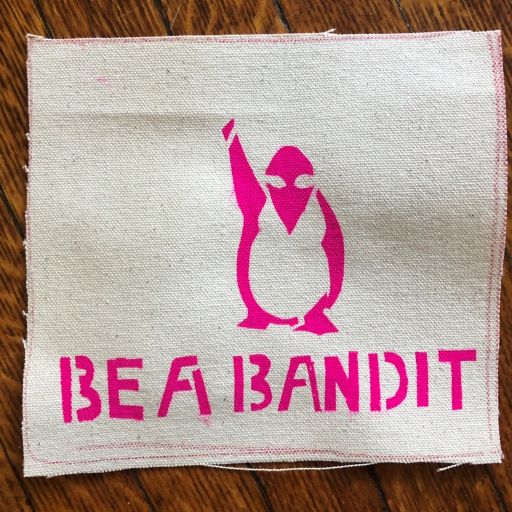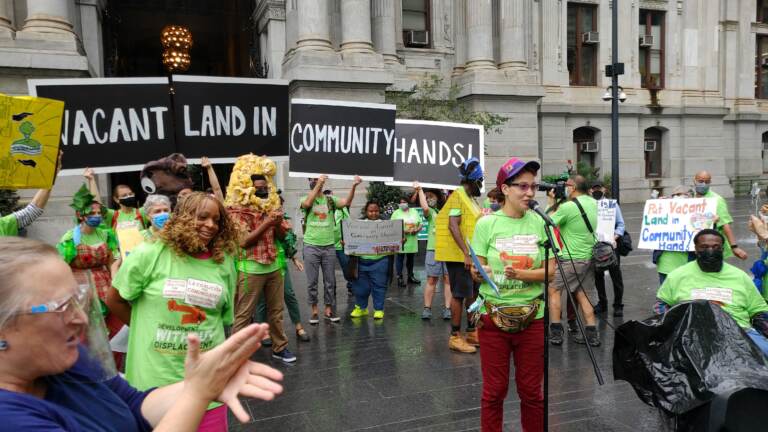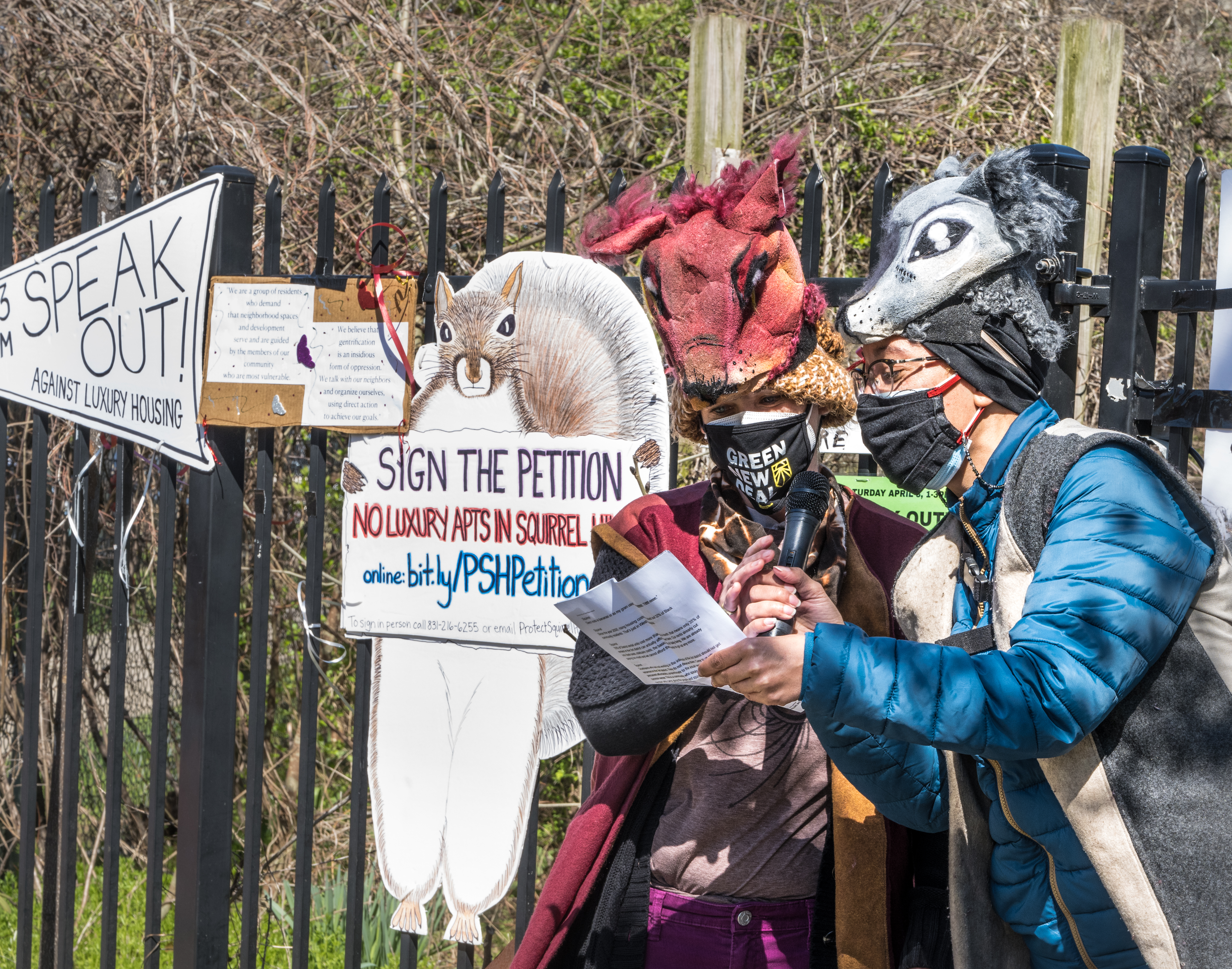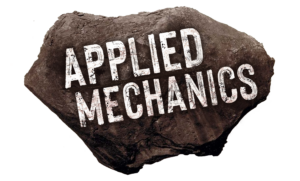
A few years ago, our eccentric band of experimental performance artists decided to do something we’d never tried before:
We decided to make political action part of our collective work.
This was a new idea for us. We’d always described ourselves as a theater company with radical politics, making political art. But we’d never really thought about deliberately investing our energy into the related-yet-opposite thing — making political action artfully.
The desire had been percolating within us for a while, when we had performed at fundraisers for victims in Charlottesville and the Pulse shooting, and opened for Russian political dissident Nadya Tolokonikova. But to go a step further felt different, and maybe hubristic. After all, what did we know about organizing? What did we know about which tactics worked? About who were good allies and who were not, about which groups were effective, and how to tell the difference? In short: where the hell were we to start?
Back in 2016, brilliant radical rabbi, Jessica Rosenberg had recommended us to Christi Clark of the Philadelphia Coalition for Affordable Communities. We’d joined the Coalition, while still unsure of what our joining would mean, or how a gaggle of performance art weirdos might be useful to their strategy. After spending a few years on the fringes of that coalition, we decided to start DAC — the Direct Action Committee — with the idea that despite all our not-knowing, we were going to try to be as useful as possible. Suffice to say, we didn’t stay on the fringes long after that. We committed ourselves to one of the biggest and most important fights in Philadelphia — the fight for affordable housing.
_____________________________________________
Applied Mechanics was founded in 2009.
We were a group of 20-somethings, strange performance artists, who moved to Lenapehoking — specifically the city of Philadelphia — because we heard it had a thriving art scene.
We are settlers.
There are two types of art scene in Philadelphia (and probably a lot of cities in the world):
The art scene — flourishes in empty warehouses, people’s front porches, community centers, abandoned Rite Aids, underground music venues, parks, church basements and cafes. Makes work that is rooted in and continues to build community.
The Art $cene — happens in symphony halls, big theaters, museums, well-funded art institutions — in short, anything tourists know about.
When a city develops an Art $cene, without supporting the art scene, then the city and its people become vulnerable to gentrification. And artists, especially settler artists, are complicit in that.
Philadelphia’s mayor in the late 90s, Ed Rendell, had made a concerted effort to create an Art $cene in Philadelphia. He christened South Broad Street as the Avenue of the Arts. He pulled strings to get struggling theater companies into brick-and-mortar, gorgeous spaces along that street. The plans for the new Kimmel Center for the Arts rolled out. There was an effort to make Philadelphia a hub for Art Tourism, which went hand in hand with an effort to gentrify the city. This era is also the origin of the 10-year Tax Abatement (passed in 2000, end of Rendell’s term). The abatement STILL allows developers to go 10 years without paying any property tax on new development — in other words, driving up the taxes of native Philadelphians without paying a penny themselves, thereby driving Philadelphians out of Philadelphia.
The infrastructural investment in an art scene, in order to make an Art $cene, was part of an effort to make America’s poorest large city attractive to wealthier folks.
These two scenes overlap until they don’t — artists will keep supplementing their unpaid work in the “small s” scene with well-paid work in the “big S” $cene until they are priced out of their own neighborhoods. As rich folks move in for the Art $cene, artists have to either move farther out of the city or give up art altogether, especially if they choose to have children.
As artists, we become part of the problem the moment we move here.
We either join the fight or we become part of the problem.
________________________________________________
Our work with the affordable housing coalition started with caucusing at City Hall.
The Caucus Room is a moment before council is in session where anybody can go up to the antechambers and LOBBY — that is to say, hound, cajole, harass and coax your council members about whatever issue you want. Before pandemic in Philadelphia, that moment was 10:30 on a Thursday.
Sometimes we had props — Halloween candy, stickers, weird hats. Christi Clark would talk us through the basics of what promises of support we needed, and we would head up to the 3rd floor of city hall prepared to charm, harass and win over our city council members. In other words, we PERFORMED.



There is essentially no difference between improvising for a room full of politicians and a room full of drunk people in a late-night cabaret except for context. Be faster and funnier than your heckler. Charm them and get them on your side, or make them look foolish for not being on your side. They are not as well-equipped to win that battle as you are — not if you have ever held your own on a weird night upstairs at Franky Bradley’s. That’s a magic power that can help manifest actual policy.
Our coalition ended up winning a legislative battle that year, in 2019, with the help of Councilman Derek Green. We had a party with fellow community members — streamers and cake and a sweet dj —and the Coalition ended up asking Applied Mechanics to step up and join their Steering Committee. We were gearing up to design our next campaign and we were getting excited and feeling the momentum and then —
March 2020 hit.
And suddenly, we were going to have to get a lot more creative.
_________________________________________________
Nobody was ready for tanks in the streets of Philadelphia.
Nobody was ready for the body count of COVID-19.
Nobody was ready for the protest on 676, when the Philadelphia police under Danielle Outlaw committed what the UN later recognized as human rights violations on civilians.
Nobody was ready for cops beating mothers and stealing babies out of cars the night after Walter Wallace’s murder.
Nobody was ready for curfews and white folks with bats guarding a police station on Girard or a statue of Christopher Columbus or a damn Target on Washington Avenue.
Nobody was ready for the noise of explosions all night, every night that summer.
Somehow, regular folks in Philadelphia created incredible bonds of mutual aid and solidarity, and rose up to do extraordinary things. Ready or not.
________________________________________________
Who decides what happens in our neighborhoods?
The people! The people! The people decide!

Since March 2020, Severin has been seen doing the work of the Direct Action Committee wearing costumes as varied as:
- a Valentine’s Day fairy,
- a squirrel,
- a hazmat suit and
- a 9-foot-tall unicorn puppet (courtesy of Spiral Q).



This special day in September is the day that Councilmember Jaime Gauthier is finally introducing the legislation we’ve all been talking about, pouring over, dreaming on and pushing for since 2020: the Land Justice Bill to give communities first dibs on all city-owned vacant land. It not only gives community groups first pick, it allows a 5 year lease time for the group to discuss what they want to do with the land, figure out their funding, meet and change their minds and meet again. Meanwhile, market-rate developers will have to wait their turn. If the legislation passes, it will be a game-changer in America’s poorest large city.
The lead up to this bill had been long: lots of meetings with council members, sometimes even weekly meetings with our champion, Council member Jamie Gauthier, who made time to meet with us throughout the 2020 uprising. Our coalition did teach-ins, in which we discussed things like: What is a Community Land Trust? How do we assure permanent affordability? How does land disposition in the city of Philadelphia work and how do we want it to change? How can we build our power as this bill moves through council? As Applied Mechanics’ Direct Action Committee, we were learning on our feet and happy not to have all the answers.
As we accumulated knowledge about organizing, we were also deploying our skills as DIY artists. When Mayor Kenny tried to cut the Housing Trust Fund entirely out of the 2020 budget during the pandemic, we designed and painted signs for an elaborate visual stunt down the center of Broad Street, 17 people long: We need homes to #stayathome! FUND HOUSING SAVE LIVES! Organizing with ACT UP, we delivered over 30 body bags to city hall, tagged with names of people the Coalition had lost due to COVID — some of them disabled folks who could not get safe housing in pandemic, and were shunted into nursing homes where the virus took their lives. Artists from the community — Tai Verley, Jackie Soro and Jordan McCree — joined us and held vigil over the body bags as a durational performance piece. That night, we hung the tags from the body bags on the trees in front of the mayor’s house — brought the death toll to his front door. This was also one of the first nights of the Occupy PHA tent encampment on the parkway, one of the most heroic and extraordinary actions to come out of the 2020 uprising, and a great victory in the housing fight in Philadelphia. Direct Action Committee members stood in solidarity with the encampment during the wary stand-off with Philadelphia police, and celebrated when finally, Philadelphia Housing Authority caved and did their job — giving safe housing to a multitude of folks who really needed it, and who were willing to hold the line until they got it. We learned so much from those extraordinary activists from ACT UP and Occupy PHA, and from fellow artists who got heavily involved in that battle to help see it through to victory.



In the throes of the November 2020 election mania, when Philadelphia vote count briefly became the center of national attention, Direct Action Committee continued hustling for affordable housing. With ACT UP, we dressed in hazmat suits and went to Councilmember Alan Domb’s house on Rittenhouse Square, shaming him for walking out of a vote to extend the eviction moratorium. The live stream showed Mechanician Izzy Sazak improvising through a bullhorn and leading the gang in chants — Alan Domb is a super-spreader! Izzy’s bullhorn prowess (honed as a punk singer in the small “s” art scene) came to bear again in front of Biden’s transition headquarters in Wilmington, where our ACT UP comrades lead the charge – demanding that Potus put housing at the top of this COVID recovery agenda. And in the midst of all this, we marched. For Breonna Taylor, Mumia Abu-Jamal, the MOVE children, George Floyd, Ahmaud Arbery, Walter Wallace, for PILOT programs, for abolition, for accountability, we marched and went to vigils and sang and blocked traffic and did jail support and marched.
We always saw fellow artists at these marches. Sometimes the marches were organized by fellow artists. Artists have a place in this fight.



________________________________________________
From the November 2021 meeting notes of the Direct Action Committee:
Severin’s words —
Direct Action is existing. It’s alive, it’s fast paced. It’s not a one-off project, but rather a continual process. For me being an art-ivist means finding ways to put my art where my mouth is. As a transplant I am faced with the question of whether or not I belong here. I understand that as an artist, as a human I must strive to be in thoughtful, intentional, and respectful conversation with the land and its inhabitants, past +present+ future. I belong here. I belong to the land. We as a collective believe housing is a human right. We reach out to care for each other and we do that through our art.
Art is many things, it is birthright, it is a portal into a new reality, it is the vehicle to the future.
________________________________________________________________________
What we do as individuals in our neighborhoods matters.
Whether we are renters or homeowners, but especially if we are settlers, how we conduct ourselves as individuals within the community matters.
Creating systems of mutual aid with neighbors — helping each other, looking out for each other, protecting one another — is an essential part of this work.
What can a theater company do, since it is not an individual?
For Applied Mechanics, Direct Action Committee is the organizational version of being a good neighbor – learning about our responsibility to the city and holding ourselves to it. As members of the art scene we make connections with our neighbors, support those demonstrating need, and uplift the work of our community.
If we choose to be passive, we are part of the problem.
Applied Mechanics is active, we are engaged citizens of Philadelphia.
